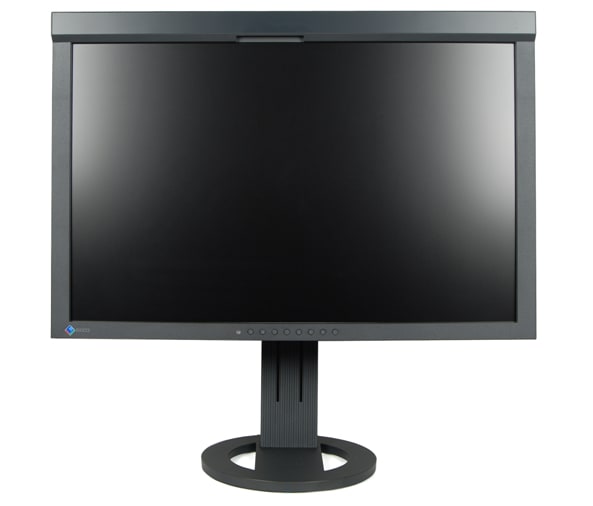Pros
Cons
Introduction
Front
{{section_header}}{{section.name}}{{/section_header}}

Back
{{section_header}}{{section.name}}{{/section_header}}

Side
{{section_header}}{{section.name}}{{/section_header}}

Stand
{{section_header}}{{section.name}}{{/section_header}}
The stand allows for a lot of adjustment. As well as being able to lift the monitor by 6.8 inches, it also allows it to tilt up by up to 30 degrees. A rotating base also allows it to rotate: useful if you are showing a design to a group of people and want them all to be able to see the design straight on.




In the Box
{{section_header}}{{section.name}}{{/section_header}}
As well as the display itself, you get:
- DVI cable
- DisplayPort cable
- USB cable
- Power cable
- Removable screen hood
- User guide and software CD
Contrast
{{section_header}}{{section.name}}{{/section_header}}
We measured the maximum contrast ratio of this display at 587:1, from a black level of 0.442 cd/m2 and a peak white of 248 cd/m2. More on how we test contrast.

Uniformity
Color Temperature
{{section_header}}{{section.name}}{{/section_header}}
The color temperature of this display was extremely stable: we only saw a very, very small variation in the color temperature of the whites on the screen, ranging from the brightest whites to the dim greys. More on how we test color temperature.

Color Curves
{{section_header}}{{section.name}}{{/section_header}}
A smooth color curve makes for good colors on screen, with small color changes in the images being accurately reflected on the screen. The {{product.model}} excelled here, producing very accurate colors that reflected the colors in our test images. More on how we test color curves.

Color Gamut
{{section_header}}{{section.name}}{{/section_header}}
The color gamut of this display was similarly spot-on, with the only minor error being a slight shift in the blue. More on how we test color gamut.

Viewing Angle
{{section_header}}{{section.name}}{{/section_header}}
This display fared somewhat poorly in our viewing angle test, with the contrast ratio falling to 16:1 at a 45 degree angle. That's a big drop, but this monitor is not designed to be used in a group setting: it is designed to be used by one user.

Calibration
{{section_header}}{{section.name}}{{/section_header}}
We usually calibrate the monitors that we test with an X-Rite i1 Display Pro, but that wasn't needed with this one. Instead, we used the self-calibration feature of the display, where it flips down a sensor and shows some colors on screen, then re-calibrates its own settings.
Connectivity
{{section_header}}{{section.name}}{{/section_header}}
Two DVI ports are offered, as well as a single DisplayPort and a USB input. There are no VGA, HDMI or analog video inputs available. This limits the ability to connect to laptops or older computers, but if you are spending this much on a monitor, you are probably spending far more on a computer to go with it.
A 2-port USB 2.0 hub is built into this display, but the ports for connecting devices are only located on the back of the panel in a position that is somewhat hard to reach, making it unusable for devices like USB thumb drives.


Controls & Menus
{{section_header}}{{section.name}}{{/section_header}}
The controls are located on the bottom of the bezel. When the on-screen menu is open, these double as navigation buttons. We found the controls and menu to be easy to use, but the structure of the on-screen menu does require some button pressing to navigate.


Other Features
Comparison Overview
{{section_header}}{{section.name}}{{/section_header}}
It is perhaps cruel to compare a $200 monitor to a $2800 one, but it is a lesson in how a bit more performance can cost a lot more. It comes as no surprise that the Eizo is the better performer, but the Viewsonic is a good enough display for most users. The Eizo trounced the Viewsonic in every test, is better designed, more flexible and easier to use, but the Viewsonic has the advantage of being about $2600 cheaper.
Comparison Overview
{{section_header}}{{section.name}}{{/section_header}}
It is no surprise that the Eizo is the better performer in most of our performance tests, but the Samsung proved to be no slouch, posting good scores across the board. So, if extreme color accuracy is not that important to you, then the Samsung is the better (and less expensive) pick. But if you are looking for a more professional, precise monitor for photography or design, the Eizo is the one to choose, as long as your bank balance can stand it.
Comparison Overview
{{section_header}}{{section.name}}{{/section_header}}
It is no surprise that the Eizo is the better performer in most of our performance tests, but the HP postied good scores across the board as well. So, if extreme color accuracy is not that important to you, then the HP is the better (and less expensive) pick. But if you are looking for a professional, precise monitor for photography or design, the Eizo is the one to choose, as long as your bank balance can stand it.
Conclusion
{{product.vanity}}
The ColorEdge CG245W is not cheap. At about $2800, it is way more expensive than most monitors, and most of the features it offers are not needed by most users. But those who need them will find them real time savers. Features like the self-calibration, screen hood and the ability to simulate color blindness could be invaluable to professional designers and serious photographers, and for these users, the price is probably worth it.
Photo Gallery
{{photo_gallery "Front Image", "Back Image", "Side Image", "Stand Photo", "Stand A", "Stand B", "Stand C", "Controls Photo", "Connectivity Photo 1", "Connectivity Photo 2", "Menu Photo", "Controls Photo"}}
Meet the tester
Richard Baguley is a veteran writer who has written about technology ranging from Alphabet to Zip file utilities. He has contributed to pretty much every major tech publication, including Amiga Format Magazine, PC World, Wired, CNET, Toms Guide, Forbes, and many others. He lives in the Boston metro area with his wife, dog, and an indeterminate number of cats.
Checking our work.
Our team is here to help you buy the best stuff and love what you own. Our writers, editors, and experts obsess over the products we cover to make sure you're confident and satisfied. Have a different opinion about something we recommend? Email us and we'll compare notes.
Shoot us an email

